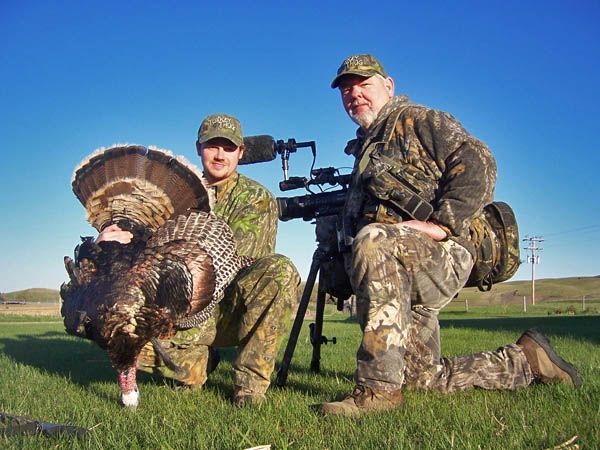
John Phillips - May 28, 2012
Hide the Cameraman:
“A big mistake many people often make when videoing a hunt is that the cameraman may not hide as well as he should,” Ronnie Strickland explains. “Hunting with a cameraman, means twice the amount of noise and twice the amount of scent, and you’re twice as likely to spook the game as you will be if you’re hunting by yourself. This reason is why when we’re hunting or filming, we cover everything but the camera lens with Mossy Oak camouflage. We even cover the tripod legs, and we take extra head nets and gloves with us to be prepared if someone loses one. We always try to take a stand in the shade, which is very-important, because as I’ve mentioned, the only thing we don’t have covered with Mossy Oak is our camera lens. If the sun hits that camera lens and a deer or a turkey sees the reflection of the sun on the lens, that animal will spook and get out of there. But, there’s no way to cover-up the camera lens or to camouflage it. Also, don’t forget that back cover is often far-more important than front cover. If you’re silhouetted in a tree stand, an animal can pick you out just as easily as if you’re walking the top of a ridge with no trees in front of you or behind you. I always carry bungee cords with me, pruners and a folding saw. Many times when I get into a tree, I’ll cut brush or limbs and bungee those limbs behind me to make sure I’ve got my silhouette covered behind me.”
Have Quality Video Sound:
“I have a sign in each of the edit rooms here at Mossy Oak that says, ‘If it doesn’t sound good, it doesn’t look good,’” Strickland reports. “Many times when people want to video their hunts, they’re all-consumed with the idea of getting the hunter taking the shot and the animal taking the arrow. The last thing they think about is the quality of the sound. But, I believe the sound is just as important, if not more-important, than the video itself. If people will be talking in the video, you’ve either got to get within 2 feet of the person talking (if you have a built-in mic), or you’ll have to invest in wireless mics. Notice I said the word, “mics,” plural instead of “a mic” singular. Many people concentrate so much on video and so little on audio that they don’t produce a good bowhunting video. Imagine going to a movie in a movie theater, and the movie has bad, irritating sound. If you’ve ever been to a movie like this, you know you’ll have a tough time listening to what’s happening, even though you can see what’s happening.
“The only way to make sure that you get good sound on your videos is to wear a set of headphones. If you’re touching the camera, and you can hear a scuffing sound every time you touch the camera, then you can fix that problem right then. If every time your hunter moves his head, you hear a scratching sound, then you’ve got to fix your wind screen, buy a wind screen or move the mic, so that when the hunter turns his head, he doesn’t brush the head of the mic. We use two different types of microphones when we’re filming. One mic is called a net mic, and it’s unidirectional, which means it picks-up sounds from all directions. We have a 15-foot cord for it, so we can set it out on the ground. So, that’s one channel input that’s picking-up great sounds, like a turkey gobbling or a deer walking through the leaves, or ducks quacking as they’re coming-in over a beaver pond. Then, we put a wireless mic on the hunter himself, so he can talk during the hunt. The cameraman wears headphones, and I’ll put one of the headphones in my ear and the other headphone above my ear to enable me to still hear all the natural sounds. I’m convinced that to get really-good audio, you’ve got to have a camera that has two mic inputs, so that you can hear the hunter, and the viewer can hear everything else going-on around the hunter.”



























